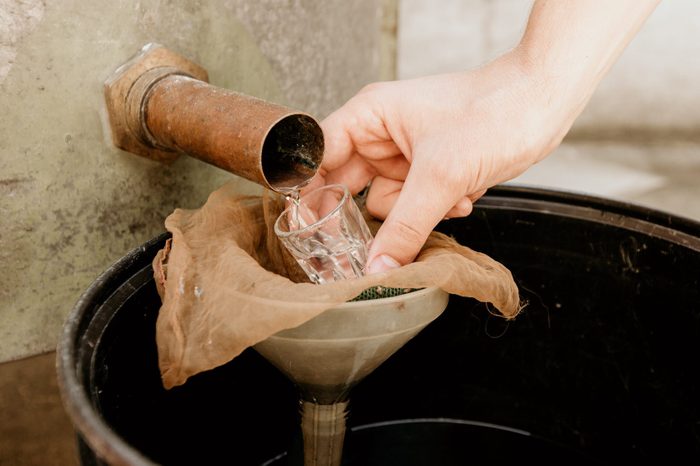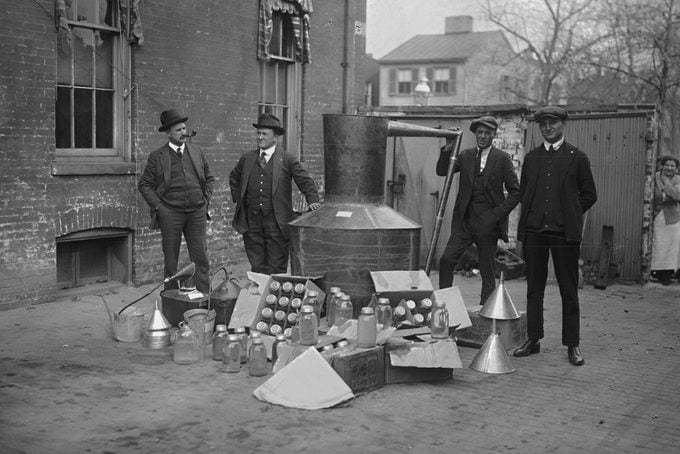What Is Moonshine?
Updated: Jul. 31, 2023

What is moonshine, exactly? A catch-all term for illegal liquor, moonshine has no set recipe, a dangerous reputation and a fascinating history. Here's the story.
Whether you associate it with homemade “bathtub whiskey” or the big business of bootlegging during Prohibition, moonshine plays a potent role in American history.
The question of what is moonshine is complex—technically, moonshine refers to illegally made liquor or alcohol, but you can buy moonshine in liquor stores today. Here’s a rundown on the origins of moonshine, some squirm-worthy facts about its brewing and ways to enjoy it in mixed drinks.
On This Page
What Is Moonshine Alcohol Exactly?
Moonshine is a catch-all word for illegally made booze. The name comes from the practice of brewing illegal liquor in secret, often at nighttime. While moonshine has a romantic sound, unregulated liquor is usually wildly potent. More descriptive names include rotgut, skull pop, firewater, white lightning and hooch.
The History of Moonshine

Early Beginnings of Moonshine
Moonshine is commonly associated with Prohibition, but its roots go back further to the American Revolution. To pay for the war, the government decided to tax liquor, driving many to distill and sell liquor on the sly.
Many farmers relied on whiskey during lean years; if corn isn’t fetching a high price at harvest time, why not turn it into the more valuable whiskey? The taxes were quite unpopular, to say the least—tax collectors were sometimes tarred and feathered when they came to town to collect!
The tension built into the 1791 Whiskey Rebellion, during which President George Washington deployed 13,000 troops to Pennsylvania, quashing the rebels. (Here are some early American vintage recipes, if you’re curious about what our Founding Fathers might have nibbled.)
Moonshine During Prohibition
In subsequent decades, moonshiners around the country, from the deep South to New York City, continued to brew illegal liquor. When Prohibition outlawed liquor sales in 1920, moonshine came into its heyday. Suddenly, homemade booze was an enormously profitable industry.
Organized crime largely took over the making and distributing of moonshine—long gone were the days when bootleggers smuggled moonshine in flasks concealed in their boots. Professional bootleggers zoomed around in cars, driving so zippily they took to racing each other.
Most cultural references for moonshine come from the rip-roaring 1920s, from bulky bodyguards looming before secret speakeasy doors to flappers high-kicking in fringe skirts. If you weren’t friends with the Great Gatsby, though, reality wasn’t quite as glamorous.
Moonshine could be downright dangerous since the lack of regulation led to a lack of scruples for many moonshiners. Adding lye to moonshine sped up the fermentation, with the slight downside of being poisonous. Brewing moonshine in car radiators allowed lead to seep into the ‘shine, making drinkers go blind, or worse. These dubious practices outlasted Prohibition, carrying into the 1960s, when the government hired the great Louis Armstrong to record radio commercials warning of the dangers of moonshine.
How Moonshine Is Made & What Is In It?

Since moonshine was, by definition, undefined and unregulated, the process and ingredients vary greatly. While liquors like whiskey (or whisky) follow traditional recipes, use time-honored distilling techniques and are bottled at a specific alcohol content, moonshine follows no real pattern. Moonshine can be made with anything fermentable, like grain, sugar or fruit, and might end up with a wide range of finished alcohol content.
That said, moonshiners of yore usually used mashed corn, yeast and sugar to make moonshine. As the mix fermented, the sugar produced ethanol. Distilled enough, the brew delivered a boozy kick.
What Does Moonshine Taste Like?
In the past, moonshine might be made with just about any grain, alcohol concentration and sugar level, with results ranging from vile “rotgut” to something credibly akin to vodka or whiskey.
Today, you can buy moonshine on some liquor store shelves, and we highly recommend that over seeking out home-brewed ‘shine. We like Midnight Moon, a nationally-distributed brand founded by NASCAR racer Junior Johnson, based on his own father’s moonshine recipe. Made from 100% American corn and distilled in small batches, it mimics the best-possible moonshine. Try the eye-watering 100-proof, 80-proof or an array of flavors, from apple pie to pickles (seriously).
How to Serve Moonshine
While you can sip moonshine straight or on the rocks, it also tastes great in mixed drinks. Try moonshine stirred into lemonade, mixed with Bloody Mary mix or in place of vodka in a Moscow Mule. You might also make your own apple pie moonshine, which uses a mix of store-bought liquors to pack a punch.
